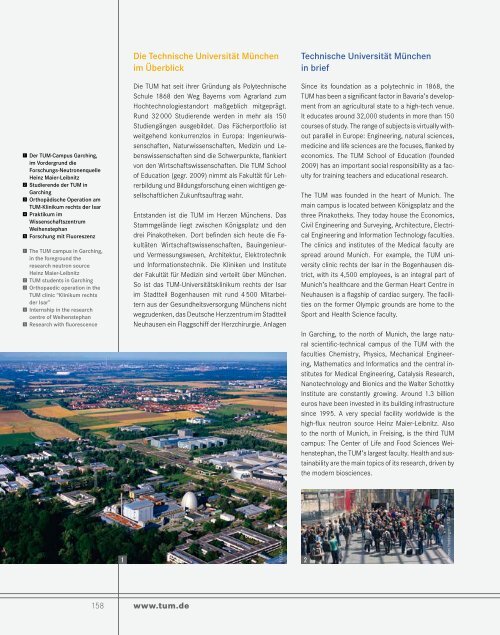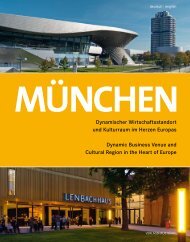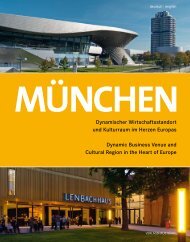Buch_Muenchen
You also want an ePaper? Increase the reach of your titles
YUMPU automatically turns print PDFs into web optimized ePapers that Google loves.
A Der TUM-Campus Garching,<br />
im Vordergrund die<br />
Forschungs-Neutronenquelle<br />
Heinz Maier-Leibnitz<br />
S Studierende der TUM in<br />
Garching<br />
D Orthopädische Operation am<br />
TUM-Klinikum rechts der Isar<br />
F Praktikum im<br />
Wissenschaftszentrum<br />
Weihenstephan<br />
G Forschung mit Fluoreszenz<br />
A The TUM campus in Garching,<br />
in the foreground the<br />
research neutron source<br />
Heinz Maier-Leibnitz<br />
S TUM students in Garching<br />
D Orthopaedic operation in the<br />
TUM clinic “Klinikum rechts<br />
der Isar”<br />
F Internship in the research<br />
centre of Weihenstephan<br />
G Research with fluorescence<br />
Die Technische Universität München<br />
im Überblick<br />
Die TUM hat seit ihrer Gründung als Polytechnische<br />
Schule 1868 den Weg Bayerns vom Agrarland zum<br />
Hochtechnologiestandort maßgeblich mitgeprägt.<br />
Rund 32 000 Studierende werden in mehr als 150<br />
Studiengängen ausgebildet. Das Fächerportfolio ist<br />
weitgehend konkurrenzlos in Europa: Ingenieurwissenschaften,<br />
Naturwissenschaften, Medizin und Lebenswissenschaften<br />
sind die Schwerpunkte, flankiert<br />
von den Wirtschaftswissenschaften. Die TUM School<br />
of Education (gegr. 2009) nimmt als Fakultät für Lehrerbildung<br />
und Bildungsforschung einen wichtigen gesellschaftlichen<br />
Zukunftsauftrag wahr.<br />
Entstanden ist die TUM im Herzen Münchens. Das<br />
Stammgelände liegt zwischen Königsplatz und den<br />
drei Pinakotheken. Dort befinden sich heute die Fakultäten<br />
Wirtschaftswissenschaften, Bauingenieurund<br />
Vermessungswesen, Architektur, Elektrotechnik<br />
und Informationstechnik. Die Kliniken und Institute<br />
der Fakultät für Medizin sind verteilt über München.<br />
So ist das TUM-Universitätsklinikum rechts der Isar<br />
im Stadtteil Bogenhausen mit rund 4 500 Mitarbeitern<br />
aus der Gesundheitsversorgung Münchens nicht<br />
wegzudenken, das Deutsche Herzzentrum im Stadtteil<br />
Neuhausen ein Flaggschiff der Herzchirurgie. Anlagen<br />
Technische Universität München<br />
in brief<br />
Since its foundation as a polytechnic in 1868, the<br />
TUM has been a significant factor in Bavaria’s development<br />
from an agricultural state to a high-tech venue.<br />
It educates around 32,000 students in more than 150<br />
courses of study. The range of subjects is virtually without<br />
parallel in Europe: Engineering, natural sciences,<br />
medicine and life sciences are the focuses, flanked by<br />
economics. The TUM School of Education (founded<br />
2009) has an important social responsibility as a faculty<br />
for training teachers and educational research.<br />
The TUM was founded in the heart of Munich. The<br />
main campus is located between Königsplatz and the<br />
three Pinakotheks. They today house the Economics,<br />
Civil Engineering and Surveying, Architecture, Electrical<br />
Engineering and Information Technology faculties.<br />
The clinics and institutes of the Medical faculty are<br />
spread around Munich. For example, the TUM university<br />
clinic rechts der Isar in the Bogenhausen district,<br />
with its 4,500 employees, is an integral part of<br />
Munich’s healthcare and the German Heart Centre in<br />
Neuhausen is a flagship of cardiac surgery. The facilities<br />
on the former Olympic grounds are home to the<br />
Sport and Health Science faculty.<br />
In Garching, to the north of Munich, the large natural<br />
scientific-technical campus of the TUM with the<br />
faculties Chemistry, Physics, Mechanical Engineering,<br />
Mathematics and Informatics and the central institutes<br />
for Medical Engineering, Catalysis Research,<br />
Nanotechnology and Bionics and the Walter Schottky<br />
Institute are constantly growing. Around 1.3 billion<br />
euros have been invested in its building infrastructure<br />
since 1995. A very special facility worldwide is the<br />
high-flux neutron source Heinz Maier-Leibnitz. Also<br />
to the north of Munich, in Freising, is the third TUM<br />
campus: The Center of Life and Food Sciences Weihenstephan,<br />
the TUM’s largest faculty. Health and sustainability<br />
are the main topics of its research, driven by<br />
the modern biosciences.<br />
FOTAG/Artur Gerngross<br />
Andreas Heddergott/TUM<br />
158<br />
www.tum.de




